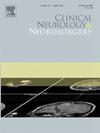Improvement in cranial nerve palsies following treatment of intracranial aneurysms with flow diverters: Institutional outcomes, systematic review and study-level meta-analysis
IF 1.8
4区 医学
Q3 CLINICAL NEUROLOGY
引用次数: 0
Abstract
Background
Cranial nerve (CN) palsies are rare presenting symptoms of intracranial aneurysms. Our objectives were to report our institutional outcomes and study-level meta-analysis summarizing rates of improvement and identifying factors associated with recovery from CN symptoms after flow diversion.
Methods
We conducted a retrospective review of our institutional database for patients with intracranial aneurysms presenting with CN palsies who underwent treatment with flow diversion between 2015 and 2023. Systematic review of the literature was performed using Medline, EMBASE, Cochrane, as well as manual citation searches. Random effects meta-analysis was used.
Results
Thirteen of 136 studies were included in the meta-analysis and were combined with our institutional data. The pooled rate of improvement in any CN palsies following flow diversion was 71 % (95 %CI, 60 %-82 %, n=322). Patients presenting with CN II deficits were less likely to improve following treatment compared to other CN deficits (pooled OR [pOR] 0.32, 95 %CI, 0.16–0.63, n=224). The pooled rate of clinical improvement was 53 % in CNII deficits (95 %CI, 42 %-65 %, n=80) and 80 % in other CN deficits (95 %CI, 71 %-88 %, n=106). An increased rate of improvement was associated with acute intervention (pOR 9.12, 95 % CI, 2.26–36.73, n = 71) and radiographic aneurysm occlusion (pOR 5.29, 95 %CI, 1.66–16.90, n=118).
Conclusions
Flow diversion improves CN palsy outcomes in patients with symptomatic intracranial aneurysms. The lower rate of improvement in visual acuity compared to other CN deficits may point to a different mechanism of injury or potential recoverability in these patients.
使用血流分流器治疗颅内动脉瘤后颅神经麻痹的改善情况:机构成果、系统回顾和研究层面的荟萃分析
背景颅神经(CN)麻痹是颅内动脉瘤的罕见症状。我们的目的是报告本机构的研究结果和研究层面的荟萃分析,总结血流改道术后CN症状的改善率,并确定与CN症状恢复相关的因素。方法我们对本机构数据库中2015年至2023年间接受血流改道术治疗的颅内动脉瘤CN麻痹患者进行了回顾性回顾。我们使用 Medline、EMBASE、Cochrane 以及人工引用检索对文献进行了系统回顾。结果 136 项研究中有 13 项纳入了荟萃分析,并与我们的机构数据相结合。血流改道术后任何CN麻痹的改善率为71%(95%CI,60%-82%,n=322)。与其他中枢神经缺损相比,中枢神经II缺损患者接受治疗后病情改善的可能性较小(汇总OR [pOR] 0.32, 95 %CI, 0.16-0.63, n=224)。CNII缺陷的临床改善率为53%(95%CI,42%-65%,n=80),其他CN缺陷的临床改善率为80%(95%CI,71%-88%,n=106)。急性干预(pOR 9.12,95 %CI,2.26-36.73,n=71)和动脉瘤放射学闭塞(pOR 5.29,95 %CI,1.66-16.90,n=118)可提高改善率。与其他CN缺损相比,视力改善率较低,这可能表明这些患者的损伤机制或潜在恢复能力不同。
本文章由计算机程序翻译,如有差异,请以英文原文为准。
求助全文
约1分钟内获得全文
求助全文
来源期刊

Clinical Neurology and Neurosurgery
医学-临床神经学
CiteScore
3.70
自引率
5.30%
发文量
358
审稿时长
46 days
期刊介绍:
Clinical Neurology and Neurosurgery is devoted to publishing papers and reports on the clinical aspects of neurology and neurosurgery. It is an international forum for papers of high scientific standard that are of interest to Neurologists and Neurosurgeons world-wide.
 求助内容:
求助内容: 应助结果提醒方式:
应助结果提醒方式:


